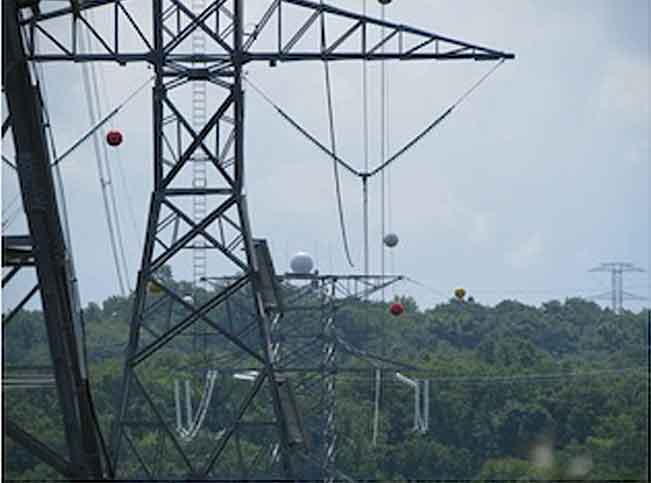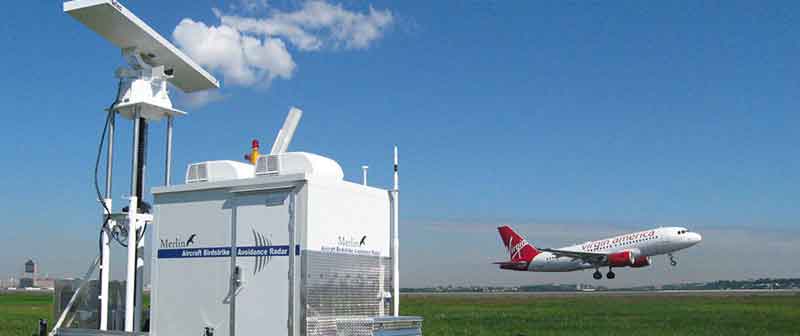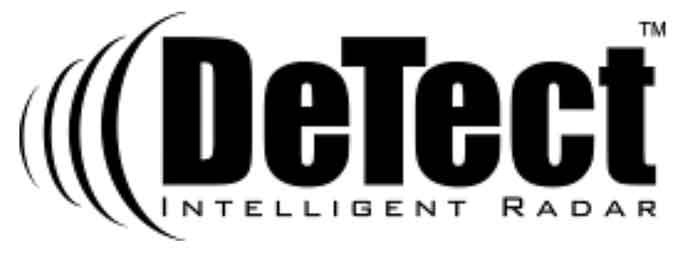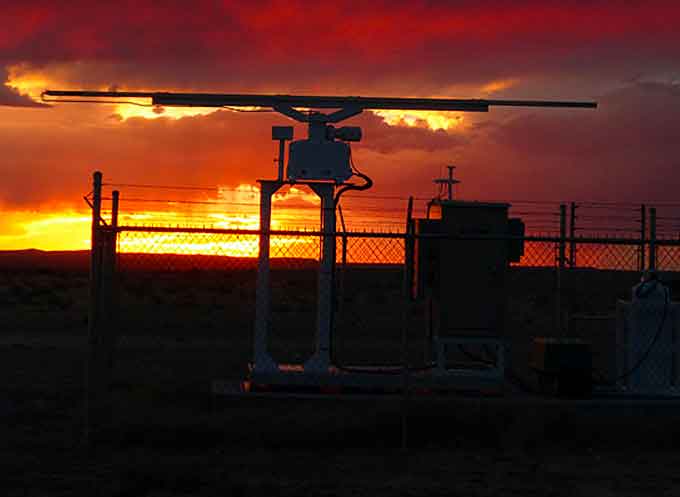In response to the Dark Sky initiative to reduce light pollution and customer demand, DeTect developed the HARRIER Aircraft Detection Lighting Systems (ADLS) in 2008 for automatic obstruction lighting activation for aviation obstructions such as wind farm turbines, high voltage transmission lines and communication towers.
The US Federal Aviation Administration (FAA) has released its Performance Assessment Report on the DeTect, Inc. HARRIER Aircraft Detection Lighting System (ADLS).
FAA Airport Technology Research and Development Branch (ATR) personnel conducted the performance assessment of the X-band radar version of the HARRIER® ADLS) with the purpose of determining if the DeTect HARRIER ADLS met the ADLS requirements specified in Chapter 14 of FAA Advisory Circular (AC) 70/7460-1L, “Obstruction Marking and Lighting.”
 FAA ATR personnel assessed a DeTect HARRIER X-band ADLS installed by the Public Service Electric and Gas Company (PSEG) on transmission towers near Aeroflex-Andover Airport (12N), located in Andover, New Jersey.
FAA ATR personnel assessed a DeTect HARRIER X-band ADLS installed by the Public Service Electric and Gas Company (PSEG) on transmission towers near Aeroflex-Andover Airport (12N), located in Andover, New Jersey.
This performance assessment, consisting of demonstrations, flight testing, and data analysis was conducted on June 24, 2016.
In the performance assessment, a series of flight patterns were flown against the DeTect HARRIER ADLS to demonstrate whether it could meet the FAA performance requirements specified in AC 70/7460-1L.
The DeTect HARRIER X-band ADLS performed according to the manufacturer’s specifications and met the performance requirements identified in AC 70/7460-1L.
The HARRIER ADLS provides reliable, continuous 360 degree radar surveillance of the airspace around wind farms, communications towers, power lines and installations that require aircraft obstruction lighting from the ground level to above aircraft flight altitudes, automatically issuing signals to activate obstruction lighting when aircraft are detected at a defined outer perimeter.
HARRIER meets or exceeds all regulatory requirements including the recently issued US Federal Aviation Administration (FAA) Advisory Circular and Canadian NAVCAN requirements and well as various EU standards.
(Learn More. Starry skies are a vanishing treasure because light pollution is washing away our view of the cosmos. It not only threatens astronomy, it disrupts wildlife, and affects human health. The yellow glows over cities and towns — seen so clearly from space — are testament to the billions spent in wasted energy from lighting up the sky. To help raise public awareness of some of the issues pertaining to light pollution, Loch Ness Productions in collaboration with the International Dark-Sky Association has created a 6.5-minute “public service announcement” called Losing the Dark. It introduces and illustrates some of the issues regarding light pollution, and suggests three simple actions people can take to help mitigate it. Courtesy of The International Dark-Sky Association and YouTube.)
DeTect’s ADLS delivers reliable, continuous 360 degree radar surveillance of the airspace around sites automatically activating obstruction lighting only when aircraft are detected at a defined outer perimeter.
The HARRIER ADLS visual warning system is compatible with all wind energy turbines, control and communication networks, and obstruction lighting systems.

“DeTect’s HARRIER ADLS is the most cost-effective system on the market and includes multiple internal fail-safes, long-range detection and tracking, and specialized algorithms to minimize light pollution while ensuring safe aviation operations” said Jesse Lewis, General Manager of DeTect Americas.
The HARRIER ADLS collision avoidance system is based on DeTect’s HARRIER ASR used for non-cooperative aircraft detection and UAV sense-and-avoid and the system provides aircraft detection out to 24+ miles with continuous tracking and lighting signal activation (through SCADA or direct interfaces).
The HARRIER ADLS is highly customizable for each site and application with multiple alert zones and activation perimeters, and is available as a stand-alone system or integrated with other sensors and warning devices such as audible beacons.
The typical national standard (FAA, Transport Canada) minimum range is 3- 4 miles and HARRIER exceeds the expected minimum by a safety factor of more than 400%.
Additionally, HARRIER’s speed measurement and heading monitoring exceeds agency requirements for range for detection and activation.
The HARRIER ADLS also provides continuous recording of operational data (aircraft detections and flight tracks, lighting activation events, and system information) to internal SQL Data systems with customizable auto-reporting features for record keeping and compliance documentation.
With DeTect’s MERLIN processor add-on, a HARRIER ADLS can additionally provide ADLS, bird radar and drone surveillance functionality from a common sensor platform.

HARRIER ADLS advantages include:
- Long range capability provides greater margin of safety.
- Compatible with all turbines, communication networks & lighting systems
- Low cost of acquisition & O&M State-of-the-art solid state
- High MTBF Doppler solid-state radar technology
- Lower installation cost, ground-based sensor packages
- Multi-function capable for bird & intruder detection
- Backed by full parts & labor warranty
- The HARRIER Aircraft Detection Lighting System is the most widely deployed and proven ADLS system on the market with systems installed and operating in the US, Canada and Europe.
DeTect is a fully integrated radar company with US radar research, engineering and manufacturing facilities in Florida, and offices in California, Washington DC, and England.
 The company is a leader in applied remote sensing technologies for small radar cross section targets such as unmanned aerial vehicles (UAVs), drones and birds.
The company is a leader in applied remote sensing technologies for small radar cross section targets such as unmanned aerial vehicles (UAVs), drones and birds.
Other DeTect products include HARRIER Security and Surveillance Radars, the DroneWatcher™ drone detection and defense system, and MERLIN™ Aircraft Birdstrike Avoidance Radars and avian radars for aviation and environmental applications.
















